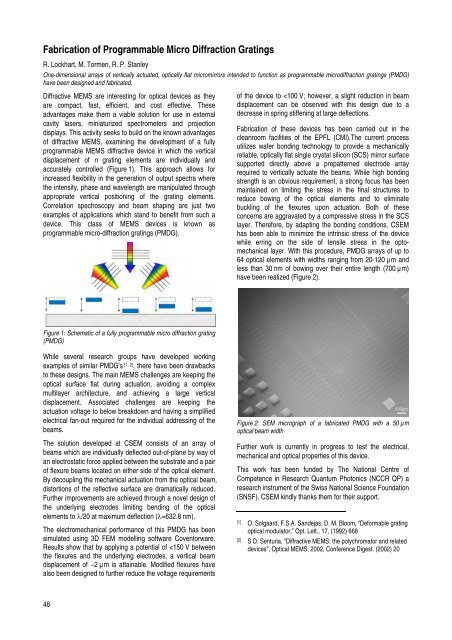CSEM Scientific and Technical Report 2008
CSEM Scientific and Technical Report 2008
CSEM Scientific and Technical Report 2008
You also want an ePaper? Increase the reach of your titles
YUMPU automatically turns print PDFs into web optimized ePapers that Google loves.
Fabrication of Programmable Micro Diffraction Gratings<br />
R. Lockhart, M. Tormen, R. P. Stanley<br />
One-dimensional arrays of vertically actuated, optically flat micromirrors intended to function as programmable microdiffraction gratings (PMDG)<br />
have been designed <strong>and</strong> fabricated.<br />
Diffractive MEMS are interesting for optical devices as they<br />
are compact, fast, efficient, <strong>and</strong> cost effective. These<br />
advantages make them a viable solution for use in external<br />
cavity lasers, miniaturized spectrometers <strong>and</strong> projection<br />
displays. This activity seeks to build on the known advantages<br />
of diffractive MEMS, examining the development of a fully<br />
programmable MEMS diffractive device in which the vertical<br />
displacement of n grating elements are individually <strong>and</strong><br />
accurately controlled (Figure 1). This approach allows for<br />
increased flexibility in the generation of output spectra where<br />
the intensity, phase <strong>and</strong> wavelength are manipulated through<br />
appropriate vertical positioning of the grating elements.<br />
Correlation spectroscopy <strong>and</strong> beam shaping are just two<br />
examples of applications which st<strong>and</strong> to benefit from such a<br />
device. This class of MEMS devices is known as<br />
programmable micro-diffraction gratings (PMDG).<br />
Figure 1: Schematic of a fully programmable micro diffraction grating<br />
(PMDG)<br />
While several research groups have developed working<br />
examples of similar PMDG’s [1, 2] , there have been drawbacks<br />
to these designs. The main MEMS challenges are keeping the<br />
optical surface flat during actuation, avoiding a complex<br />
multilayer architecture, <strong>and</strong> achieving a large vertical<br />
displacement. Associated challenges are keeping the<br />
actuation voltage to below breakdown <strong>and</strong> having a simplified<br />
electrical fan-out required for the individual addressing of the<br />
beams.<br />
The solution developed at <strong>CSEM</strong> consists of an array of<br />
beams which are individually deflected out-of-plane by way of<br />
an electrostatic force applied between the substrate <strong>and</strong> a pair<br />
of flexure beams located on either side of the optical element.<br />
By decoupling the mechanical actuation from the optical beam,<br />
distortions of the reflective surface are dramatically reduced.<br />
Further improvements are achieved through a novel design of<br />
the underlying electrodes limiting bending of the optical<br />
elements to λ/20 at maximum deflection (λ=632.8 nm).<br />
The electromechanical performance of this PMDG has been<br />
simulated using 3D FEM modelling software Coventorware.<br />
Results show that by applying a potential of








